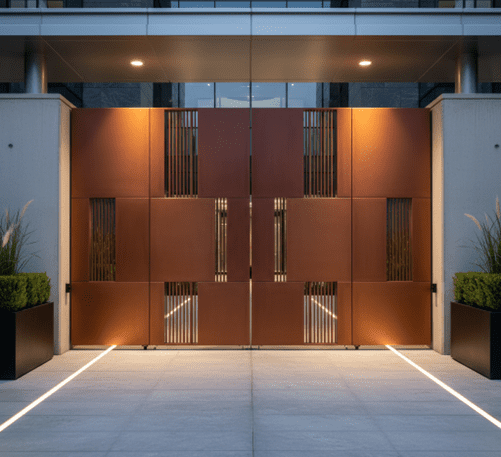The design world has fallen in love with warm metallics. For decades, chrome, stainless steel, and brushed nickel dominated our kitchens, bathrooms, and car trim. Today, however, the trend has decisively shifted toward the rich, earthy tones of copper and bronze. Whether it’s the stunning satin finish of new luxury tapware or the sleek, dynamic bronze accents on a high-end SUV, these colours are everywhere, signifying an era of modern luxury and organic sophistication.
This resurgence of copper and bronze presents an important question for consumers, designers, and manufacturers alike: How do you achieve this coveted look without sacrificing performance? The two primary approaches are using the true, raw metal itself or employing a high-tech, performance-driven powder coating to achieve the aesthetic.
For anyone who values longevity, consistency, and low maintenance—especially in high-use environments—understanding the critical difference between these two options is vital. This article puts real metal finishes head-to-head against modern coating technology, examining their durability, maintenance requirements, and practical application in the real world.
The Unmistakable Allure of True Copper and Bronze
There is no denying the intrinsic beauty of genuine copper and bronze. Copper, with its vibrant orange-red hue, and bronze, a deeper, warmer, and slightly darker alloy, offer a richness that instantly elevates a design. They possess a depth of colour and reflectivity that is uniquely organic, connecting us to historical design and natural elements.
The most celebrated characteristic of these metals is the process of patina. Patina is the chemical process of oxidation and weathering that forms a thin layer on the metal’s surface. It’s what gives antique copper pots and venerable bronze statues their distinctive blue-green (Verdigris) or dark, mottled brown appearance. For some designers, this natural degradation is the goal—a visual history that proves the object is authentic.
However, patina is not just an aesthetic feature; it is a clear indication that the metal is corroding and that its surface is changing structurally. In the controlled environment of a museum, this may be acceptable. But in the demanding reality of modern living and automotive applications, a constantly changing and degrading surface is often a liability.
The Durability Dilemma of Raw Metal Finishes
When considering the practical application of raw copper or bronze, the romantic notion of a natural patina quickly clashes with the need for modern durability.
Tapware and Interior Finishes
In kitchens and bathrooms, raw metal is constantly exposed to moisture, steam, soap, cleaning chemicals, and varying water pH levels. This exposure drastically accelerates the patina process. Within weeks, what was once a bright, clean copper faucet can develop green or blue streaks. Worse yet, standard household chemicals—from bleach to acidic fruit juices—can cause immediate, irreversible etching and uneven tarnishing.
Maintaining a raw copper finish requires consistent cleaning with specific, gentle products and often a protective wax, a labour-intensive process that runs counter to the expectation of a maintenance-free modern home. Scratches, nicks, and dings also quickly penetrate the surface, leaving visible, dark marks that stand out against the raw metallic lustre.
Automotive and Exterior Applications
The challenges are magnified in the automotive world, where metals are subject to extreme conditions. Car trim, wheel accents, and exterior architectural elements must withstand road salt, abrasive grit, harsh UV radiation, acid rain, and high-pressure washing. Raw bronze or copper simply cannot offer the level of protection required in these environments. The beautiful bronze wheel accent on a luxury Range Rover, for instance, would rapidly discolour, pit, and degrade without a robust, engineered barrier.
Enter the Modern Solution: Performance Powder Coating
For manufacturers and consumers who desire the stunning look of copper and bronze without the inherent drawbacks of the raw metal, powder coating is the undisputed champion. This technology offers the best of both worlds: a perfect metallic aesthetic combined with industrial-grade protection.
Powder coating is a dry finishing process where finely ground pigment and resin particles are electrostatically charged and sprayed onto a grounded substrate (metal component). The part is then cured under heat, causing the powder to melt, flow, and form a seamless, chemical bond with the surface.
Modern powder coating technology has perfected the art of metallic finishes. Coatings can replicate the exact hue, depth, and texture of various bronze and copper alloys, from a bright, mirror-like copper to a deep, oil-rubbed bronze, all while providing superior durability. The finish can even include subtle metallic flakes to mimic the characteristic shimmer of the metal itself.
A Head-to-Head Durability Test: The Clear Winner
When directly comparing the performance metrics, the results are overwhelmingly in favour of the engineered finish.
|
Feature |
Raw Copper/Bronze |
Powder Coated Finish |
|
Corrosion/Tarnish Resistance |
Highly susceptible to moisture, acids, and chemicals; requires constant maintenance to prevent patina. |
Exceptional. Provides an impermeable barrier that seals the metal, offering superb resistance to corrosion, rust, and tarnish. |
|
Scratch/Abrasion Resistance |
Soft, vulnerable surface that scratches and dents easily, leading to deeper corrosion points. |
Superior Toughness. A thick, bonded layer that resists chipping, scratching, and abrasion far better than raw metal. |
|
UV Resistance |
Poor. Sunlight accelerates oxidation and can lead to uneven discolouration. |
Excellent. Formulations include UV-stable resins that prevent fading and chalking, maintaining colour consistency outdoors. |
|
Colour Consistency |
Highly variable; changes constantly over time (patina); difficult to match components. |
Perfect Consistency. Controlled application ensures the exact colour is maintained across multiple pieces and for the life of the product. |
Zero Maintenance, Lifetime Look
The single greatest advantage of a powder-coated copper or bronze finish is its zero-maintenance performance. A powder-coated tap, car wheel, or railing simply requires standard cleaning with soap and water.9 There is no special waxing, polishing, or worrying about acidic detergents causing permanent damage. The coating acts as an impenetrable shield, protecting the underlying metal and preserving the finish’s aesthetic integrity for years.10
This unparalleled durability is why powder coating has become the standard for architectural elements, marine applications, and high-performance automotive parts. It provides a finish that is not only beautiful but engineered to last.
The Verdict: Enduring Luxury
The trend toward copper and bronze is here to stay, but the conversation has moved past mere aesthetics to focus on intelligent, long-lasting applications. While the natural patina of a raw metal holds a certain charm, it is simply not practical for the rigorous demands of modern design, particularly in tapware and automotive environments.
For designers and consumers seeking the sophisticated, warm metallic look of copper or bronze—but demanding consistency, zero maintenance, and industrial-grade durability—powder coating is the only logical choice. It provides a luxurious finish that performs flawlessly year after year, guaranteeing that the stunning look you chose on day one remains just as impactful a decade later.
Ready to find the perfect durable metallic finish for your next project? Contact our experts today to discuss your specific powder coating requirements.

 07 3375 6777
07 3375 6777